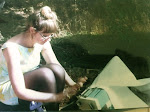SPECTRES OF A BROKEN BODY
the first Solo exhibition by Adelaide artists Claire Marsh
18/5- 5/7 at Carclew House
Curated by Adele Sliuzas
Shelter, 2011, Furs, beeswax, fibreglass, thread
I first came across Claire's work at the end of last year, and I was really excited to meet her and learn more about her practice. She is a really interesting person and it is so great to work with her, both for this exhibition and another coming up at Format at the end of the year. You might recognise Claire's work from the AGSA Graduate Exhibition, her work was on the cover of the catalogue, and in the advertising. A small, furry/spikey creature huddled in the centre of a persian rug. She also showed at the Helpmann Academy grad show, and was included in the PICA exhibition Hatched.
Untitled no.7, 2011, squid ink on velum, human hair, thread,
The exhibition features works on velum, as well as sculpture and video, and is open Monday to Friday during Carclew's office hours. We are also planning an "Up late at Carclew" for later next month, so that you can check out the exhibition, maybe see what artists in residence Andrew Humphries and Ruby Chew are up to, and have a drink or two at the beautiful Carclew House. Stay tuned for details.
Check out Claire's Website for more information about her practice.
Untitled 2, 2011, squid ink on vellum
This is the Catalogue Essay that I have written for the exhibition:
Claire Marsh’s practice explores the body; its force, its thresholds
and its relation to the self and other bodies. Through processes of visual and
physical mutations, Marsh talks about what she calls “the silent, the
creaturely and the horror of the self.”












